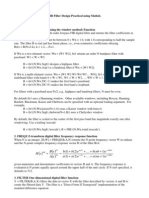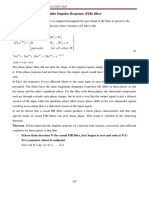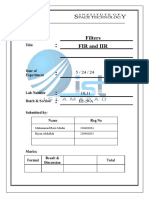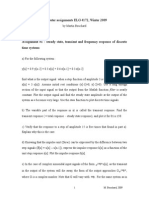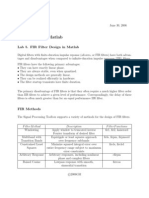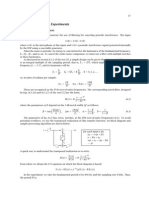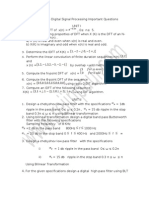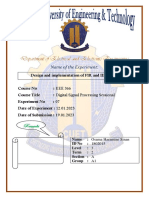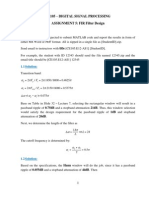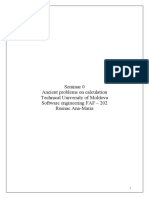Digital FIR Filter Design: A. Windows Method
Digital FIR Filter Design: A. Windows Method
Uploaded by
Tommy ManCopyright:
Available Formats
Digital FIR Filter Design: A. Windows Method
Digital FIR Filter Design: A. Windows Method
Uploaded by
Tommy ManOriginal Title
Copyright
Available Formats
Share this document
Did you find this document useful?
Is this content inappropriate?
Copyright:
Available Formats
Digital FIR Filter Design: A. Windows Method
Digital FIR Filter Design: A. Windows Method
Uploaded by
Tommy ManCopyright:
Available Formats
University of Qatar, College of Engineering, Electrical Eng. Dept.
503456 Digital Signal Processing Lab (3) Spring 2008 Name -----------------------------------------------------------------------------------
Digital FIR filter Design
A. Windows Method
In this method the student will follow the necessary steps in order to come out with the complete FIR-window filter: 1. Selection of the desired frequency response. 2. Selection of a window function then estimate N. 3. Obtain hD(n) truncated to N. 4. Obtain N coefficients of window function w(n) 5. Obtain FIR filter coefficient h(n) = hD(n) * w(n) The types of filter supported by this method are: Low-pass, High-pass, Band-pass, and Band-stop filters. The key high level command in toolbox is the fir1 command. The syntax for the basic fir command is: b = fir1(N-1, Fc); The basic command computes and returns N-point impulse response coefficients of an FIR filter with a cutoff frequency of Fc, the command returns the N-points coefficients in the vector b arranged in ascending negative power of z. b(z) = b(0) + b(1)z-1 + b(2)z-2 + .. The parameter N-1 specifies the order of the filter. The cutoff frequency Fc is normalized to the Nyquist frequency. By default the basic fir1 command applies a Hamming Window and assumes a Low-pass filter type (or Band-pass filter if Fc is specified in vector format). The general command is: b = fir1(N-1, Fc, filter type, window);
where filter type low high stop pass And where Window type w= w= w= w= w= boxcor(N); blackman(N); hamming(N); hanning(N); kaiser(N, beta); for rectangular windows for balckman windows for hamming windows for hanning windows for Kaiser windows for for for for Low-pass filters High-pass filters band-Stop filters Band-pass filters
In practice, the window command is often embedded into the fir1 command.
Problem
Design LPF with fP = 1 kHz. fs = 1.5 kHz. Fs = 10 kHz. w = Hamming.
Analytical calculation
From fP and fs the transition width will be Df = (1.5 - 1) / 10 = 0.05 (normalized to Fs). When we lookup the windows table, we will find out that for hamming window N = 3.3 / Df So, the filter length N will be 66. Now the cutoff frequency is changed because of the smearing effect of the window, to be at the half of the transition width. So, fc = fc + 0.5/2 = 1.75 kHz. Then fc (normalized to fN) = 1.75 /5.0 = 0.35.
MATLAB solution
1. Write down the next MATLAB commands
Fs = 10000 fc = 0.35; N = 66; wn = hamming(N); hn = fir1(N-1, fc, wn); [H, f] = freqz(hn, 1, 512, Fs); mag = 20 * log10(abs(H)); plot(f, mag), grid ON xlabel(Frequency (Hz)) ylabel(Magnitude (dB)) 2. Goto Simulink and open a new model. From Simulink Blockset, open Discrete, then select discrete filter. 3. From DSP Blockset, open Source, then select Sin waveform. Setup the sine wave to generate discrete signal with sampling time of 1/10000. 4. From Simulink Blockset, open Sinks, then select Scope. 5. Link the 3 block together. In the Digital Filter block, change the Numerator to hn and Denominator to 1. The sampling time should be 1/10000 as well.
6. Test the model by running it for 3 different signals: 500 Hz(pass band), 1250 Hz(transition band), and 3000 Hz(stop band). Now comment on the results. Comments:
7. Create 1000 point 1000 Hz and 2000 Hz Sinusoidal waveforms:
Explanation: 200*pi will take 1000 point each point of 10,000 of sampling rate. This means that 2*pi, which is 1 cycle, will take 10 samples. The 10 samples will give a time of 1 ms. The 1 ms time is 1000 Hz sinusoidal signal. The same principle applies for the t2 and x2 vector which give a 2000 Hz sinusoidal signal t1 = linspace(0, 200*pi, 1000); t2 = linspace(0, 400*pi, 1000) x1 = sin(t1); x2 = sin(t2) 8. Test the filter by those input sequences and get y1 and y2: y1 = filter(hn, 1, x1); y2 = filter(hn, 1, x2); 9. Now plot the 2 output waveforms: plot(y1(1:200)); plot(y2(1:200)); 10. Look at the steady state output and answer this? Did the LPF worked well? How? Give comments Comments:
Problem
Design BPF using Hanning window Passband Transition width Passband ripple Fs Stopband Att. = = = = = 1500 - 2500 Hz. 50 Hz. 0.0546. 10 kHz. 44 dB.
Solution
Remember that, the new cutoff frequencies related the smearing effect will be:
fc1 = fc1 Df/2 and fc2 = fc2 + Df/2. Question What are the analytical calculations needed to get fc1 and fc2? Answer:
Question: What are the MATLAB commands needed to design and plot that filter? Answer:
Question Test your filter by creating 3 sinusoidal signals at 1000 Hz, at 2000 Hz, and 3000Hz using only Simulink. Does it work fine? Give Reasons and Comments? Answer:
You might also like
- Red Brand CannersDocument8 pagesRed Brand Cannersmystique4686No ratings yet
- Course Work 1Document9 pagesCourse Work 1Mark FreemanNo ratings yet
- Chapter 18 SB AnswersDocument9 pagesChapter 18 SB AnswersNalaka Muhandiramlage100% (1)
- Digital Filter Design Using MatlabDocument41 pagesDigital Filter Design Using MatlabKirti Susan VargheseNo ratings yet
- Signals Spectra and DSPDocument13 pagesSignals Spectra and DSPLegenGary100% (1)
- Lab 5Document3 pagesLab 5Sameera මලිත් WithanachchiNo ratings yet
- University of Kentucky: EE 422G - Signals and Systems LaboratoryDocument5 pagesUniversity of Kentucky: EE 422G - Signals and Systems Laboratoryamina sayahNo ratings yet
- FIR Filter DesignDocument58 pagesFIR Filter DesignMubeen AhmedNo ratings yet
- Lab Experiment-1 (A) Conversion of A Matrix Into Its Row Echelon FormDocument29 pagesLab Experiment-1 (A) Conversion of A Matrix Into Its Row Echelon FormVineeth KumarNo ratings yet
- CET4910 Lab7Document2 pagesCET4910 Lab7Sawera ZahraNo ratings yet
- Speech - Digital FilteringDocument4 pagesSpeech - Digital FilteringAlirezaZamaniNo ratings yet
- Filter Programs MatlabDocument8 pagesFilter Programs MatlabPreethi Sj100% (1)
- Implementation of Fir Filter in c54xDocument6 pagesImplementation of Fir Filter in c54xTarun RamapragadaNo ratings yet
- Ec 2302 DSP EceDocument3 pagesEc 2302 DSP EceThirumalai TrendchaserNo ratings yet
- Digital Signal Processing Lab Report 11 Fa19-Bee-106Document9 pagesDigital Signal Processing Lab Report 11 Fa19-Bee-106ahmararshad420No ratings yet
- Adaptive Lab Matlab Part3Document3 pagesAdaptive Lab Matlab Part3haniaafef0% (1)
- Lab 7 FDA Tool VXXDocument7 pagesLab 7 FDA Tool VXXnarmirathkaNo ratings yet
- DSP-Manual - R19Document74 pagesDSP-Manual - R19Ragha RamojuNo ratings yet
- Lab 5 - Finite Impulse Response Filtering in LabviewDocument9 pagesLab 5 - Finite Impulse Response Filtering in LabviewPragadesh KumarNo ratings yet
- Fir Filter Matlab Design PracticalDocument3 pagesFir Filter Matlab Design PracticalKola OladapoNo ratings yet
- IIR Digital Filter Structures Filter DesignDocument35 pagesIIR Digital Filter Structures Filter DesignMasterMathematicianNo ratings yet
- DSP Matlab Assignment: Submitted ToDocument7 pagesDSP Matlab Assignment: Submitted Tohim92No ratings yet
- DSP Lab 3RTDocument4 pagesDSP Lab 3RTMatlali SeutloaliNo ratings yet
- Practical No 08Document7 pagesPractical No 08nikhilnithin7893No ratings yet
- IIR Digital Filtyttyer Structures Filter DesignDocument35 pagesIIR Digital Filtyttyer Structures Filter DesignSiddarth MadanNo ratings yet
- Finite Impulse Response (FIR) FilterDocument10 pagesFinite Impulse Response (FIR) Filterabbasmiry83No ratings yet
- Finite Impulse Response (FIR) Filter: Dr. Dur-e-Shahwar Kundi Lec-7Document37 pagesFinite Impulse Response (FIR) Filter: Dr. Dur-e-Shahwar Kundi Lec-7UsamaKhalidNo ratings yet
- List Out The Advantages and Disadvantages of FIR Filt S.: PART A - (10 X 2 20)Document3 pagesList Out The Advantages and Disadvantages of FIR Filt S.: PART A - (10 X 2 20)Anonymous gAVMpR0aNo ratings yet
- DSP Lab Report 10,11Document11 pagesDSP Lab Report 10,11madnir99No ratings yet
- ECE515FL - Activity7 (FIR Filter Design)Document13 pagesECE515FL - Activity7 (FIR Filter Design)SM MecregNo ratings yet
- Sameer Jameel - Lab 10Document6 pagesSameer Jameel - Lab 10Muhammad SameerNo ratings yet
- Lowpass Fir Filter Using Hamming WindowDocument6 pagesLowpass Fir Filter Using Hamming WindowDeepthi PrabhakaranNo ratings yet
- Digital Communication Ece 304 Assignment-1Document9 pagesDigital Communication Ece 304 Assignment-1ramjee26No ratings yet
- Exp 61Document5 pagesExp 61SupriyaNo ratings yet
- Fir Filter Using Rectangular/Boxcar WindowDocument11 pagesFir Filter Using Rectangular/Boxcar WindowvijeeshalleppeyNo ratings yet
- Lab 11Document4 pagesLab 11mohsin89No ratings yet
- Lab01 EXP Filters 1112Document26 pagesLab01 EXP Filters 1112josh.ee11No ratings yet
- Lab ManualsDocument22 pagesLab ManualsHailRodNo ratings yet
- Lab 5Document14 pagesLab 5Ram MurtiNo ratings yet
- DSP CepDocument12 pagesDSP CepSameer KhanNo ratings yet
- Lab 6 - IIR Filtering Experiments: 6.1. Periodic Notch FiltersDocument13 pagesLab 6 - IIR Filtering Experiments: 6.1. Periodic Notch FiltersPhuong PhamNo ratings yet
- Digital Signal Processing - Written AssignmentsDocument6 pagesDigital Signal Processing - Written Assignmentsabinash1987No ratings yet
- Ec 2302 DSP EceDocument3 pagesEc 2302 DSP EceIshak Khan GulamNo ratings yet
- Elec9123 DSP DesignDocument7 pagesElec9123 DSP DesignSydney FinestNo ratings yet
- Exp7Document63 pagesExp7OSAMA HARAMINE SINAN 1802015No ratings yet
- Question Bank Name of Subject: EC8553 Discrete Time Signal Processing Unit I Discrete Fourier TransformDocument5 pagesQuestion Bank Name of Subject: EC8553 Discrete Time Signal Processing Unit I Discrete Fourier TransformjeevaNo ratings yet
- Lab Sheet 6 Filter Design Using MATLAB: Lab Session 6.1: Implementation of Linear Phase FIR FilterDocument15 pagesLab Sheet 6 Filter Design Using MATLAB: Lab Session 6.1: Implementation of Linear Phase FIR FilterSharmin RiniNo ratings yet
- Digital FiltersDocument42 pagesDigital FiltersrjchumaceraNo ratings yet
- 4 LabDocument13 pages4 LabMahsa SorouriNo ratings yet
- DFT 2Document31 pagesDFT 2Karthik ThirumalaNo ratings yet
- EEE 411 Lab2Document11 pagesEEE 411 Lab2Nagaraj VaithilingamNo ratings yet
- DSP 1Document6 pagesDSP 1NurulAnisAhmadNo ratings yet
- FIR1Document1 pageFIR1Er NIsarg ShahNo ratings yet
- Filtro Fir2Document16 pagesFiltro Fir2DarWin VinueZaNo ratings yet
- Ce105 - Digital Signal Processing ASSIGNMENT 5: FIR Filter DesignDocument7 pagesCe105 - Digital Signal Processing ASSIGNMENT 5: FIR Filter DesignSolitary WolfNo ratings yet
- Chapter 3Document94 pagesChapter 3Sau VanNo ratings yet
- Rajastan College of Engineering For Women: Digital Signal ProcessingDocument7 pagesRajastan College of Engineering For Women: Digital Signal Processingchandra1985No ratings yet
- Introduction To Digital Filters: Exercise 3Document3 pagesIntroduction To Digital Filters: Exercise 3KhaLiid Ibnelbachyr ܤNo ratings yet
- FIR FILTER DESIGN ANALYSIS Lab11Document6 pagesFIR FILTER DESIGN ANALYSIS Lab11ALISHBA AZAMNo ratings yet
- Some Case Studies on Signal, Audio and Image Processing Using MatlabFrom EverandSome Case Studies on Signal, Audio and Image Processing Using MatlabNo ratings yet
- Fundamentals of Electronics 3: Discrete-time Signals and Systems, and Quantized Level SystemsFrom EverandFundamentals of Electronics 3: Discrete-time Signals and Systems, and Quantized Level SystemsNo ratings yet
- Lec3 Entropy 1Document16 pagesLec3 Entropy 1Mission JEENo ratings yet
- AIT Lab ManualDocument38 pagesAIT Lab ManualHari KrishnaNo ratings yet
- Design Via Root Locus and Frequency ResponseDocument15 pagesDesign Via Root Locus and Frequency ResponseBran WzNo ratings yet
- Chap 20 SlidesDocument28 pagesChap 20 SlidesAyan NathNo ratings yet
- Contoh Soal N Gram (Bagus)Document2 pagesContoh Soal N Gram (Bagus)yeninurNo ratings yet
- Homework: ProblemDocument2 pagesHomework: ProblemReinaldy MaslimNo ratings yet
- Phishing Detection Using Clustering and Machine LearningDocument11 pagesPhishing Detection Using Clustering and Machine LearningIAES IJAINo ratings yet
- FEU CryptographyDocument26 pagesFEU CryptographyJojo CansinoNo ratings yet
- Notes 5Document23 pagesNotes 5februarydtzNo ratings yet
- Preacher Selig 2012Document22 pagesPreacher Selig 2012JaneNo ratings yet
- Camry Group Activity Bsba-Fm3aDocument12 pagesCamry Group Activity Bsba-Fm3aMaria Hannah GallanoNo ratings yet
- Lecture 6 - Ridge Regression, Polynomial Regression (DONE!!) PDFDocument26 pagesLecture 6 - Ridge Regression, Polynomial Regression (DONE!!) PDFSharelle TewNo ratings yet
- Machine Learning BasicsDocument16 pagesMachine Learning BasicsNaman SharmaNo ratings yet
- 03 Gen360 - Building Analysis Control and Analysis InterpretationDocument114 pages03 Gen360 - Building Analysis Control and Analysis InterpretationRowena PagaduanNo ratings yet
- 2021 Focal Press - Digital Audio TheoryDocument255 pages2021 Focal Press - Digital Audio TheoryMiguel Angel Pardave Barzola100% (1)
- CNS LabmanualDocument21 pagesCNS LabmanualakiraNo ratings yet
- DHCA Chapter 4 Version 1 0 WizSense SMD 4 0, Quick Pick, AI SSADocument40 pagesDHCA Chapter 4 Version 1 0 WizSense SMD 4 0, Quick Pick, AI SSADms TsNo ratings yet
- Test BankDocument16 pagesTest Bankmahmoud abdelhaiNo ratings yet
- Phase 4 Project Report 5th SemDocument6 pagesPhase 4 Project Report 5th SemAshish GoswamiNo ratings yet
- Seminar 0. Ancient Methods of CalculationDocument7 pagesSeminar 0. Ancient Methods of CalculationHolly WrayNo ratings yet
- S10 15 - 20 Orlando RojasDocument15 pagesS10 15 - 20 Orlando RojasAndré Cuadros MamaniNo ratings yet
- Short-Rate and Forward-Rate ModelsDocument31 pagesShort-Rate and Forward-Rate ModelshugoperaltaNo ratings yet
- Lecture #6 Classification of Structural Analysis Problems. Statical DeterminacyDocument24 pagesLecture #6 Classification of Structural Analysis Problems. Statical DeterminacyLUIS ISAAC LEON PARONo ratings yet
- Functional Derivative: DefinitionsDocument3 pagesFunctional Derivative: DefinitionsAdrianNo ratings yet
- IteratorDocument2 pagesIteratorkleitomtolgahansaismanNo ratings yet
- Cormen 2nd Edition SolutionsDocument99 pagesCormen 2nd Edition SolutionsManu ThakurNo ratings yet
- Num MathDocument87 pagesNum MathshubhamNo ratings yet
- Multiclass Legal Judgment Outcome Prediction For Consumer Lawsuits Using XgboostDocument20 pagesMulticlass Legal Judgment Outcome Prediction For Consumer Lawsuits Using Xgboost18UCOS150 SS METHUNNo ratings yet



















